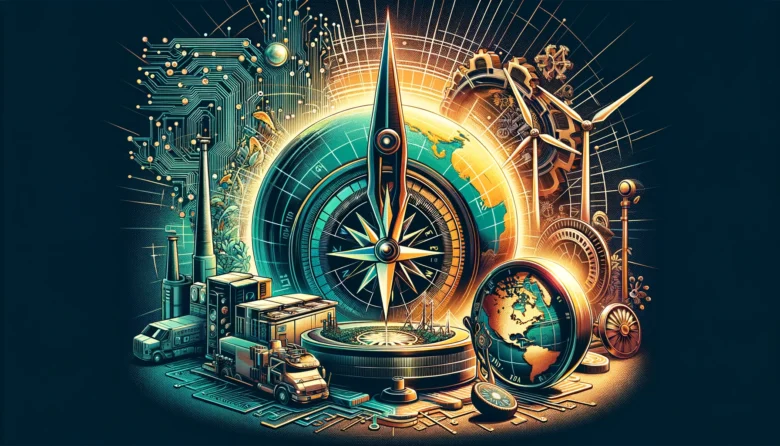Magnetism, a fundamental force of nature, has captivated human curiosity and ingenuity for millennia. This invisible force, which allows magnets to attract or repel each other and generate electricity, is not just a scientific curiosity but a cornerstone of modern civilization. The journey of magnetism, from guiding ancient sailors through the stars with a humble compass to powering the sophisticated gadgets of today’s technological era, is a fascinating story of discovery, innovation, and application.
The history of magnetism is as old as civilization itself, with the ancient Greeks and Chinese making some of the earliest observations of magnetic phenomena. The magnetic compass, a simple yet revolutionary tool, was one of the first practical applications of magnetism, fundamentally changing the course of navigation and exploration. But the compass was just the beginning. As our understanding of magnetism deepened, its applications expanded, weaving a magnetic thread through the fabric of our technological progress.
Today, magnetism is at the heart of countless technological advancements. From the vast data centers storing the world’s knowledge to the medical devices that can peer into the human body, magnetic forces play a crucial role. As we stand on the brink of new discoveries and innovations, magnetism continues to hold the promise of even more remarkable advances in technology.
In this blog, we will embark on a journey through the force of magnetism, exploring its historical roots, its pivotal role in the evolution of technology, and the exciting possibilities it holds for the future. Join us as we delve into the magnetic world, from compasses to cutting-edge technology, and uncover the enduring impact of this fundamental force on our lives and society.
The Historical Journey of Magnetism
- Ancient Observations and Uses
The story of magnetism begins in ancient times, with civilizations such as the Greeks and Chinese noting the peculiar properties of naturally magnetized stones, called lodestones. These early encounters with magnetism were shrouded in mystery and magic, as people observed the lodestone’s ability to attract iron and align itself with the Earth’s magnetic poles. The practical utility of these observations became evident with the invention of the magnetic compass in ancient China, a tool that revolutionized navigation by providing sailors with a reliable means of determining direction when stars were obscured.

- Scientific Understanding of Magnetism
The path from these mystical beginnings to a scientific understanding of magnetism was paved by curious minds over centuries. In the late 16th century, William Gilbert, an English physician, conducted systematic studies, establishing that the Earth itself behaves like a giant magnet, a concept that explained the workings of the compass. His work laid the foundation for modern magnetic science. The 19th century saw further breakthroughs, notably by Hans Christian Ørsted (a Danish scientist), who discovered electromagnetism, unveiling the intimate relationship between electricity and magnetic forces. This discovery was pivotal, leading scientists like André-Marie Ampère and James Clerk Maxwell to further unravel the laws of electromagnetism, laying the groundwork for the technological revolution to come.
- Industrial Revolution and Magnetism
During the Industrial Revolution, magnetism’s potential began to be fully harnessed. Innovators and engineers used magnetic principles to develop the first electric motors and generators, transforming mechanical energy into electrical energy and vice versa. This era marked the birth of the electrical industry, with magnetism at its core, powering the machines and factories of the industrial age. The development of the telegraph, powered by electromagnetic principles, allowed for rapid communication across vast distances, further shrinking the world and connecting societies like never before.
The historical journey of magnetism is a testament to human curiosity and ingenuity. From the lodestones of ancient mariners to the complex electrical and magnetic systems powering our modern world, magnetism has been a constant companion, guiding us toward progress and understanding. This journey, rich with discovery and innovation, has transformed our lives in countless ways, setting the stage for the magnetic marvels yet to come.
Magnetism in Modern Technology
- Electronics and Computing
In the realm of electronics and computing, magnetism plays an indispensable role. Magnetic fields are the backbone of data storage technologies, with hard drives and magnetic tapes relying on magnetism to encode and retrieve vast amounts of information. These devices manipulate magnetic materials to represent binary data, allowing for the storage and recall of information. Moreover, in the semiconductor industry, magnetic materials are used to control the flow of electrons, crucial for the function of transistors and integrated circuits. This magnetic control has been central to the development of computers, smartphones, and other electronic devices that are integral to daily life.

- Energy Generation and Transmission
Magnetism is equally vital in the generation and transmission of electrical energy. In power plants, the principle of electromagnetic induction is harnessed, where rotating magnets within coils of wire generate electricity. This process occurs in various types of power generators, from traditional coal-fired plants to nuclear and renewable energy sources like wind and hydroelectric power. Furthermore, magnetic materials are essential in transformers, devices that adjust the voltage of electrical energy for efficient transmission over long distances and for safe use in homes and businesses. The efficiency and reliability of modern electrical grids are heavily dependent on these magnetic technologies.
- Medical Technology
The impact of magnetism on medical technology is perhaps most famously illustrated by the Magnetic Resonance Imaging (MRI) machine. MRI uses powerful magnetic fields and radio waves to create detailed images of the body’s internal structures, aiding in diagnosis and treatment planning without invasive procedures. Beyond MRI, magnetic fields are explored for targeted drug delivery, where magnetic nanoparticles can be directed to specific sites within the body, potentially revolutionizing cancer treatment and other medical therapies.
- Telecommunications
In telecommunications, magnetic materials are essential for the functioning of antennas, inductors, and filters, facilitating the transmission and reception of signals. The magnetic properties of materials are exploited to enhance signal clarity and strength, enabling everything from radio broadcasts to high-speed internet connections. As we advance further into the era of wireless communication and 5G networks, the role of magnetism in developing more efficient and powerful communication technologies continues to grow.
The pervasive influence of magnetism in modern technology underscores its significance in our contemporary world. From the fundamental operations of electronic devices to the generation of power and the advancement of medical and communication technologies, magnetism remains a key force driving innovation and convenience in our daily lives and global infrastructure.
The Future of Magnetism
- Advanced Materials and Superconductivity
The future of magnetism is closely tied to the development of advanced magnetic materials and the exploration of superconductivity. Scientists are continually searching for materials with unique magnetic properties that can operate more efficiently, at higher temperatures, or with greater control over their magnetic states. This research has led to the discovery of high-temperature superconductors, materials that conduct electricity without resistance when cooled to certain temperatures. These materials have the potential to revolutionize various industries by making electrical systems vastly more efficient. Applications range from lossless power transmission to magnetically levitated transportation systems, which could drastically reduce energy consumption and open new possibilities in high-speed travel.

- Magnetism in Quantum Computing
In the sphere of quantum computing, magnetism plays a crucial role in the manipulation of quantum bits, or qubits, which are the fundamental units of information in quantum systems. Magnetic fields are used to control the state of qubits, allowing for the performance of computations that are beyond the reach of classical computers. The unique properties of quantum mechanics, combined with magnetic control, promise to unlock new capabilities in computing, including vastly superior processing power and speed, and the ability to solve complex problems in cryptography, material science, and other domains.
- Environmental and Energy Applications
Magnetism also holds promise for environmental and energy solutions. Magnetic technologies are being developed for clean energy production, such as magnetic confinement fusion, which aims to replicate the sun’s energy-generating processes in a controlled environment. Additionally, magnetic materials are being used in environmental cleanup efforts, such as the removal of pollutants from water and soil. In the energy sector, research is focused on using magnetic materials to improve the efficiency of renewable energy sources and storage systems, aiming to create a more sustainable and eco-friendly energy infrastructure.
Conclusion
Magnetism, a force that has guided explorers across unknown oceans and now powers the digital world, continues to be a fundamental element shaping human progress. Our journey from the early discovery of lodestones to the sophisticated use of magnetic fields in modern technology demonstrates not only the versatility of magnetism but also the relentless curiosity and ingenuity of humankind. The historical evolution of magnetism, from compasses to cutting-edge technologies, underscores its integral role in advancing human civilization.
As we have explored, magnetism’s influence permeates a wide array of fields, from electronics and energy generation to medical technologies and telecommunications. These applications are a testament to the transformative power of understanding and harnessing magnetic forces. Moreover, the potential future applications, including advanced materials, superconductivity, quantum computing, and environmental solutions, highlight the ongoing importance and promise of magnetic research and innovation.

The enduring impact of magnetism on our lives and society is profound, offering a lens through which to view the past, understand the present, and envision the future. As we continue to push the boundaries of what is possible, the story of magnetism is far from complete. It beckons us to delve deeper, explore further, and imagine the myriad ways in which this fundamental force will continue to shape the technological landscape and improve human life.
In conclusion, magnetism is not just a scientific phenomenon but a cornerstone of human advancement, a source of endless fascination and potential. The force of magnetism, from compasses to technology, represents a remarkable chapter in the narrative of discovery and innovation—a chapter that continues to unfold with each new discovery and technological breakthrough, promising an exciting and magnetic future.
Author’s Note
This blog aims to demystify the concept of magnetism and illustrate its significance throughout history and its profound impact on modern technology. My journey through the magnetic world was inspired by the endless possibilities that magnetism presents, from the earliest navigational aids to the forefront of quantum computing. I hope this exploration sparks your curiosity and deepens your appreciation for this fascinating force that invisibly shapes our lives.
G.C., Ecosociosphere contributor.
References and Further Reading
- “Magnetism: A Very Short Introduction” by Stephen J. Blundell – This book provides a concise overview of magnetism, its fundamental principles, and its role in the modern world.
- “The Magnetic Universe: The Elusive Traces of an Invisible Force” by J. B. Zirker – Zirker explores the history and science of magnetism, offering insights into its effects in the cosmos and on Earth.
- “Electricity and Magnetism” by Edward M. Purcell and David J. Morin – A comprehensive textbook that delves into the principles of electricity and magnetism, providing a solid foundation for those interested in the physics behind the phenomena.





Comments
Can you be more specific about the content of your article? After reading it, I still have some doubts. Hope you can help me.
I’m not sure exactly why but this weblog is loading very slow for me. Is anyone else having this problem or is it a problem on my end? I’ll check back later on and see if the problem still exists.
I enjoy the efforts you have put in this, regards for all the great blog posts.